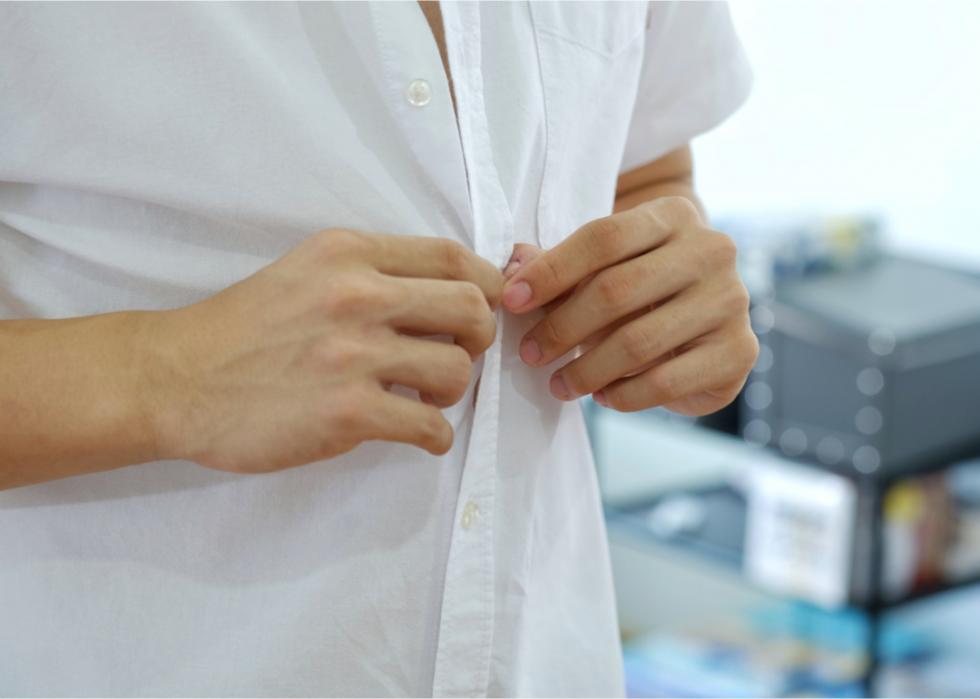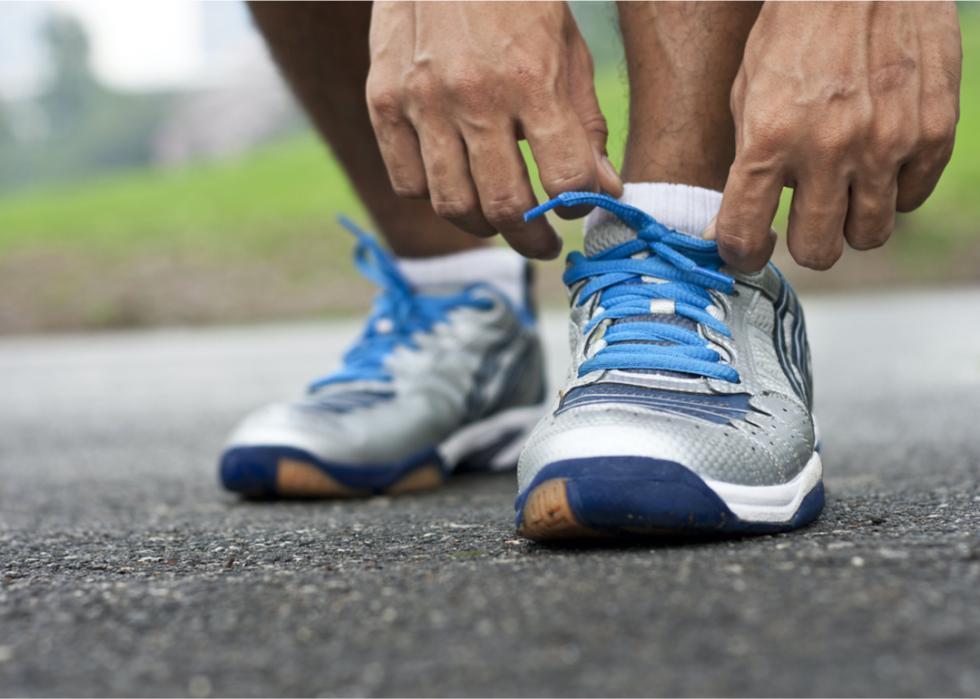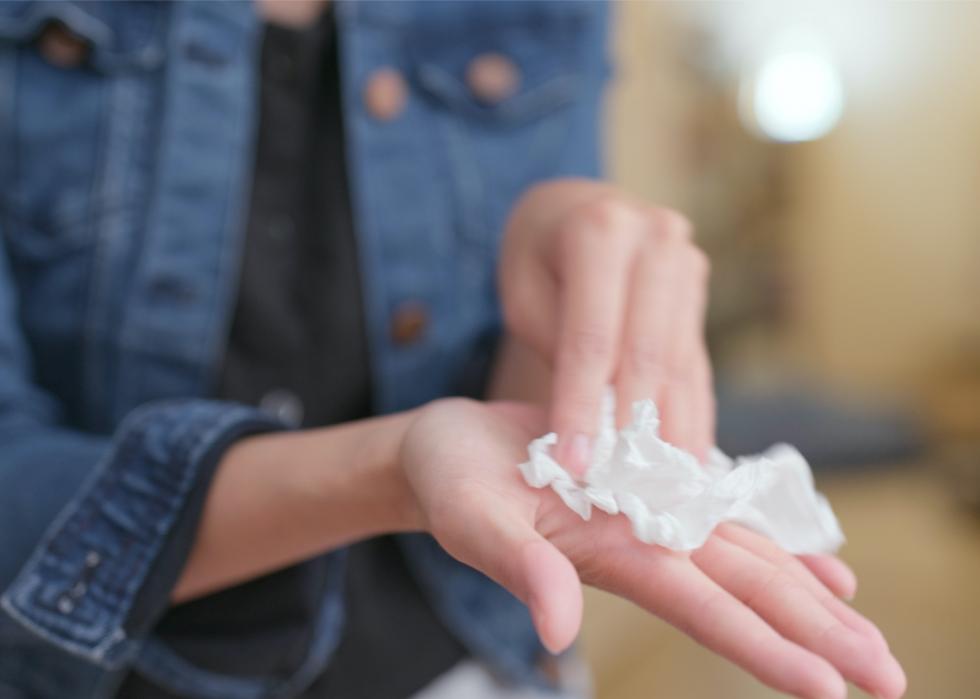
Body parts most prone to excessive sweating and their severity
This story originally appeared on Stacker and was produced and distributed in partnership with Stacker Studio.
Body parts most prone to excessive sweating and their severity
Despite the fact that sweating is normal, and even a healthy and necessary element of being human, the slightest sign of sweat in a public setting can spur anxiety and discomfort for many.
Sweating in response to exercise or hot temperatures allows the body to cool down, and is considered normal, but some people experience excessive sweating for no apparent reason, which is known as hyperhidrosis. Hyperhidrosis can be a symptom of an underlying health condition or a side effect from a medication, but in many cases, the cause of hyperhidrosis is unknown. This condition can prove to be an everyday challenge both physically and mentally. Physical effects include heat rashes or other types of skin infections, while hyperhidrosis sufferers are also prone to developing generalized anxiety disorder.
Hyperhidrosis can affect the entire body, or it may be localized to particular areas. To find the body parts most prone to excessive sweating, Duradry consulted a 2016 study published in the Archives of Dermatological Research, the oldest journal worldwide in the field of cutaneous biology and skin research. The study surveyed 393 hyperhidrosis sufferers and recorded the percentage of respondents who had indicated excessive sweating in any of seven body parts. Duradry ranked these body parts by occurrence. The sufferers were also asked about the severity of their sweating in accordance with the Hyperhidrosis Disease Severity Scale (HDSS). The percentage of sufferers that indicated barely tolerable or intolerable symptoms is also included.
Continue reading to learn which parts of the body are most susceptible to excessive sweating and how it affects physical and emotional health.

#7. Chest
- Occurrence: 27%
- Barely tolerable or intolerable symptoms: 39% (#5 most severe)
- Mean age of onset: 21.1 years
Excessive and sudden chest sweating accompanied by skin redness could be a hot flash. Another potential cause of excessive sweating of the scalp, face, or neck following consumption of drinks or food is called gustatory hyperhidrosis, or Frey’s syndrome, an indication of diabetes. People who deal with chest sweating may often choose to wear black to avoid drawing attention to visible signs of sweat in such a prominent area. The chest is one area on the body that is especially prone to heat rash, also known as sweat pimples, that are often mistaken for acne.

#6. Back
- Occurrence: 28%
- Barely tolerable or intolerable symptoms: 39% (#5 most severe)
- Mean age of onset: 20.2 years
Like chest and underarm sweating, excessive sweating of the back, which is highly visible, can make wearing white or bright colors a challenge. Not only can back sweating be embarrassing, it can cause extreme discomfort and heat rash. Hyperhidrosis of the back could be caused by anxiety, medication, or a health condition, or it might be a condition on its own. It can also be induced by menopause, and may be accompanied by skin sensitivity and hot flashes.

#5. Under breasts
- Occurrence: 29%
- Barely tolerable or intolerable symptoms: 31% (#7 most severe)
- Mean age of onset: 20.7 years
Sweating under the breasts is a common complaint, but is especially prevalent among those with larger chests, and can cause emotional embarrassment due to sweat stains as well as physical discomfort. Sweating in this region of the body can lead to intertrigo, in which skin becomes inflamed and damaged due to skin-on-skin chafing and a lack of air circulation. Once intertrigo develops, the skin is susceptible to secondary infections from bacterias such as candida or Staphylococcus aureus.
Nonmedical solutions to reduce the effects of excessive sweating under the breasts include choosing natural, sweat-wicking materials rather than synthetic fabrics like polyester, avoiding padding or extra material, and avoiding tight-fighting clothing altogether.

#4. Feet (plantar)
- Occurrence: 38%
- Barely tolerable or intolerable symptoms: 47% (#4 most severe)
- Mean age of onset: 17.6 years
A 2016 study by the American Society for Dermatologic Surgery found that patients with plantar (and palmar) primary hyperhidrosis first notice symptoms in childhood (under the age of 12). An obvious nuisance of excessive foot sweating is an unpleasant odor, but people with plantar hyperhidrosis are also at a higher risk of developing athlete’s foot, rashes and infections, and warts—all of which can lead to feelings of embarrassment, not to mention health complications. Overly sweaty feet can even cause dangerous slips and falls on certain surfaces. The International Hyperhidrosis Society recommends patients wear breathable footwear and to keep their feet as dry as possible, even if that means having to frequently change their socks and shoes.

#3. Hands (palmar)
- Occurrence: 40%
- Barely tolerable or intolerable symptoms: 54% (#1 most severe)
- Mean age of onset: 16.6 years
Excessive palm sweating can be triggered by high levels of emotional stress or anxiety. Perhaps unsurprisingly, those with excessively sweaty hands, or palmar hyperhidrosis, report feeling highly anxious in social situations such as dating where they’re expected to shake or hold hands, for example, but they also face physical challenges that may be less obvious. Palmar hyperhidrosis can cause difficulties in completing relatively simple tasks such as holding things, turning door knobs, handling paper, driving, and even makes using a touchpad for a computer or the touchscreen of a smartphone difficult.
Beyond the emotional implications of having palmar hyperhidrosis, this condition can get in the way of professionals performing their jobs. In a 2017 study published in the journal Health and Quality of Life Outcomes, researchers noted that one participant reported having palmar hyperhidrosis made her job as a nurse more difficult, from administering IVs to putting on gloves. Another member of the study said he even avoided paying for goods with paper money so the cashier wouldn’t have to touch his hands.

#2. Head/face (craniofacial)
- Occurrence: 42%
- Barely tolerable or intolerable symptoms: 50% (#3 most severe)
- Mean age of onset: 20.9 years
Excessive sweating of the face and head is nearly impossible to hide, and people who suffer from it may isolate themselves and avoid physical contact, and may even find everyday activities unbearable. Craniofacial hyperhidrosis can cause heat rash, which may be confused with acne. As is true with excessive sweating of the face, neck, or chest after consuming drinks or food, sweating of the scalp can be an indication of diabetes.

#1. Underarms (axillary)
- Occurrence: 65%
- Barely tolerable or intolerable symptoms: 52% (#2 most severe)
- Mean age of onset: 19 years
The FDA approved Botox as treatment first for underarm hyperhidrosis in 2004, though it is now also used to treat excessive sweating in other areas. The unpleasant odor that often accompanies axillary hyperhidrosis comes from sweat interacting with bacteria and opening up the area to skin infections. Experts recommend keeping the underarms free of hair and wearing breathable and absorbent fabrics, to allow sweat to evaporate more quickly.
Too many people wait years or even decades to report intolerable hyperhidrosis symptoms to their physician. As a part of 2017 research conducted by the International Hyperhidrosis Society, testimonials of patients living with excessive sweating were collected. Frequent themes shown in responses included feelings of isolation, depression, and hopelessness. It’s important to talk to your doctor right away if you feel like your physical or mental health is negatively affected by excessive sweating.
This story was produced and distributed in partnership with Stacker Studio.



